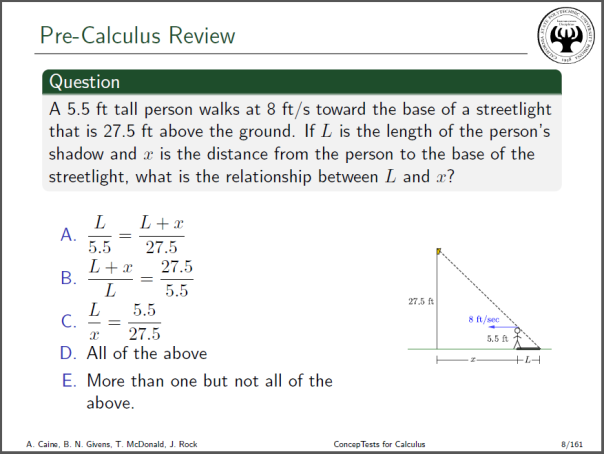Calculus I, my old friend
This blog has been dormant for some time. I’ve been involved in so many administration and grant-related projects for the last few years, that I’ve been too saturated to contribute. Also, the classes I’ve been teaching have almost all been in the upper division and so it has been harder to find topics to write about which I felt would appeal to a broader audience. This term however, the first semester at Cal Poly Pomona since our conversion from a quarter schedule to the semester schedule, I find myself teaching Calculus I after a hiatus of many years.
In the class I will be trying out our ConcepTests for Calculus (www.cpp.edu/~conceptests, developed with several of my colleagues at CPP). Through several internal grants, we’ve written a bank of think-pair-share (or clicker) questions spanning the primary Calculus and Analytic Geometry courses at CPP, including multi-variable and vector calculus. As of this writing, the bank includes questions for the last third of the first year sequence along with multi-variable and vector calculus. The questions we wrote for the remainder of the first year sequence will be available on the web later this academic year. I’m finishing the graphics development this term and trying them out in my classes. If I can manage it, I’ll try to showcase questions that I’ve tried and record some notes about student responses and discussions here on my teaching blog. Maybe the analysis will inspire you to try the questions as well.
For the first day, I just wanted to introduce the students to this teaching technique so I asked a pair of questions based on pre-calculus material. As you will see, the questions foreshadow important topics that will be covered later in the course. Here is the first one I showed them:

The first vote was unanimous on A. No need to follow up. They could identify the correct diagram between the three. We didn’t discuss it much so I don’t have a sense of precisely how they differentiated between the three options, but I can guess. Some discounted B by recognizing that measures the distance from the person to the base of the streetlight. Some discounted C by recognizing that the person is walking towards the base of the streetlight rather than away. And some probably stopped thinking after examining A, seeing that it aligned with what they understood. The follow up to this question was where the student thinking I observed got more interesting.

On the first vote, every possible answer was represented in my room full of 33 students, with no clear majority. Interestingly, the answers were spatially clustered with two groups of A’s at the wings, a group of B’s in from the left, a group of C’s through the middle and middle right, some D’s along the back and one E. Look carefully at the question. What would you vote?
I had the students pair up to discuss. The discussion made the room loud for about 90 seconds and then the discussion naturally died off. On the second vote, opinions had changed. There were many more E’s selected, but the group of C’s in the center held on as did some of the A’s from the edges. As a class we then discussed the similar triangles suggested by the figure, noted how similarity relations could lead to either A or B but not C, and how A and B were equivalent by algebraic manipulation (as they should be). I was surprised that the students did not have a name at the tip of the their tongue (like “similar triangles”) for the geometric fact that lead to the proportion, but a good number of them knew the appropriate fact. Unfortunately, a good number of them were confused too. We’ll need to work on that to set them up for later. All in all, I was really happy with using this pair of questions on the first day. It introduced the technique to the students and prompted a rich discussion, providing an early reveal of their prerequisite knowledge.
I’ll try to write a post each week to reflect on elements of the class, focusing on ConcepTests in particular. Stay tuned!
Posted on August 23, 2018, in Uncategorized. Bookmark the permalink. Leave a comment.
Leave a comment
Comments 0